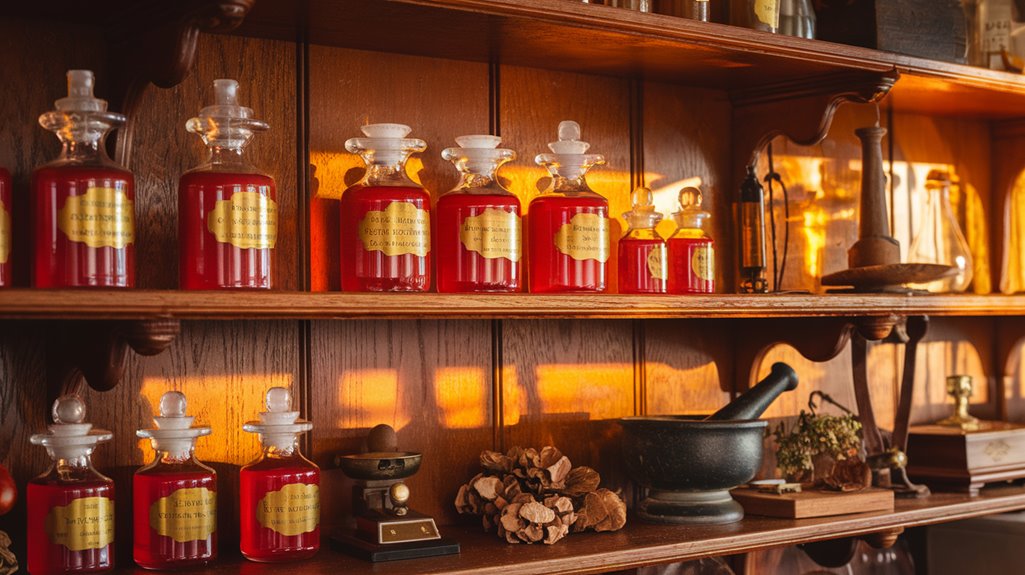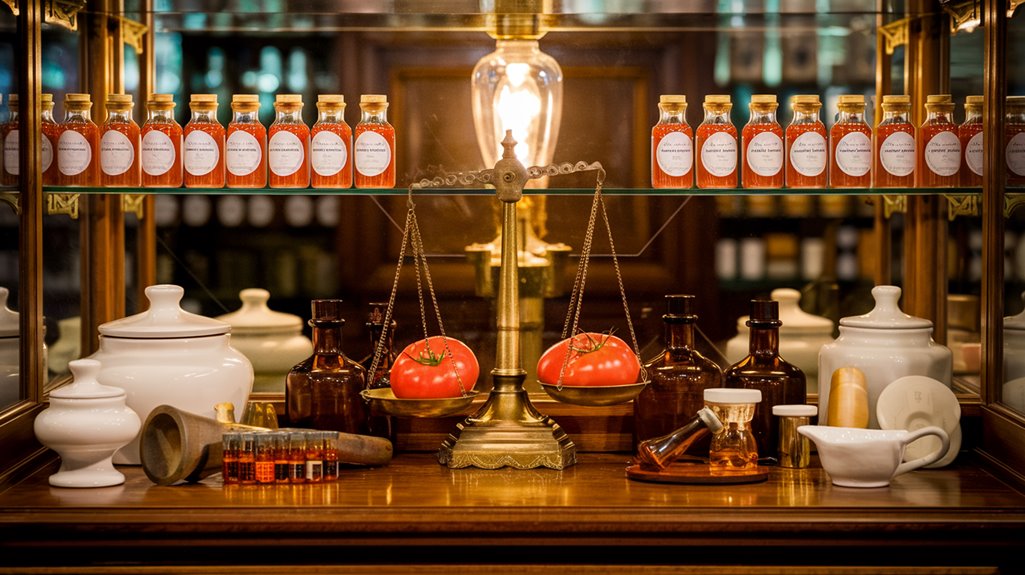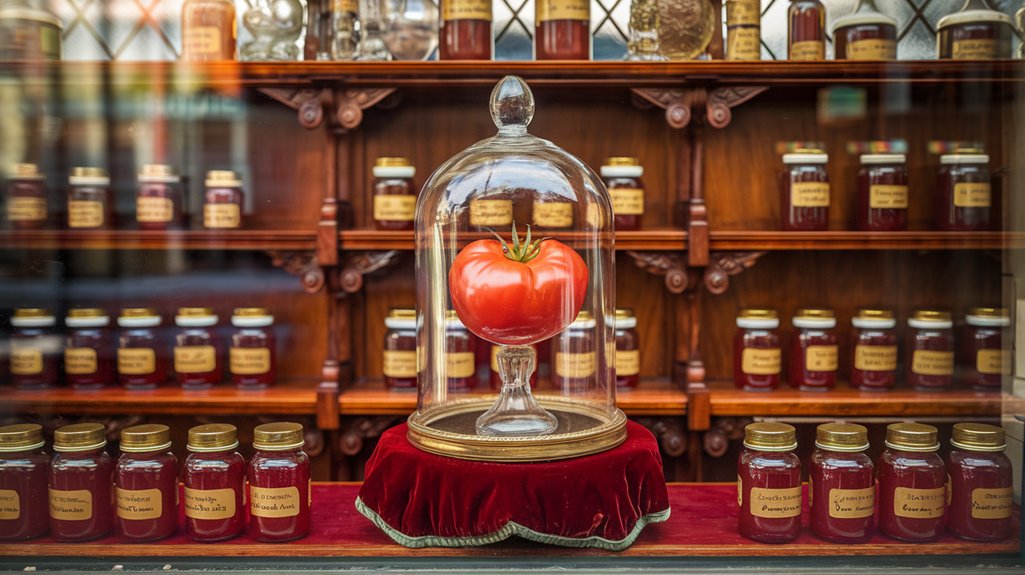Tomatoes Were Once Sold as a Medicine
You might find it hard to believe, but your ordinary garden tomato was once marketed as a miracle cure. In the 1830s, Americans weren't putting tomatoes on their sandwiches—they were swallowing them as pills and tonics. What transformed this feared "poison apple" into a supposed wonder drug? The story involves a charismatic doctor, questionable marketing claims, and a public desperate for medical solutions. It's a tale that reveals how easily fear and faith can shape our relationship with food.
The Strange Journey From Poison to Panacea

By 1840, you would've witnessed a remarkable transformation in public perception. The same fruit that sparked terror had become celebrated among medicinal herbs, with people attributing various healing properties to tomatoes.
Initially, tomatoes were considered dangerous, as European doctors warned against eating them. This shift first took hold in places like New Orleans, where chefs incorporated them into dishes by 1800, while New England remained skeptical until the 1830s. Dr. John Cook Bennett helped fuel this change by promoting tomato-based cure-alls through extensive advertising campaigns.
The French, too, shed their fears and romantically dubbed them "pomme d'amour."
It's a fascinating reversal that turned a feared fruit into a trusted remedy.
Dr. Bennett's Tomato Pills and Medical Claims
Dr. John Cook Bennett stepped up to the task in the 1830s.
Despite Bennett's credibility being questionable due to running a diploma mill, his position as a medical professor gave weight to his claims. He insisted tomatoes could cure everything from diarrhea to rheumatism, citing ancient texts as evidence.
His aggressive tomato marketing approach included publishing lecture transcripts and developing tomato pills. The public bought into his claims, leading to a wave of copycat products – many of which didn't even contain real tomatoes. A Yale graduate named Guy Phelps began marketing similar pills in 1837. He boldly claimed his pills could cure jaundice and indigestion.
You'd find newspaper articles praising tomatoes' healing powers, and people were advised to eat them three times daily. Though the medical community criticized these dubious claims, Bennett's campaign successfully transformed tomatoes from feared poison to accepted medicine.
How Tomatoes Transformed Into a Food Staple
While ancient Andean civilizations had long cultivated tomatoes, Europe's path to embracing this fruit took a dramatic turn in the 1500s.
You'll find that Europeans initially grew tomatoes merely as ornamental plants, fearing their potential toxicity due to their relationship with poisonous plants in the Solanaceae family.
The ancient Aztec and Maya civilizations cherished the tomato for its rich flavor and nutrition.
The culinary adaptation of tomatoes gained momentum in the 18th century, particularly in Italy.
You can trace this shift to several factors: economic necessity during the Little Ice Age, the Mediterranean climate's suitability for cultivation, and the recognition of their nutritional benefits.
By the 19th century, tomatoes had become a cornerstone of Italian cuisine, inspiring iconic dishes like pizza margherita and pasta al pomodoro. Roman chef Francesco Leonardi's cookbook "L'Apicio Moderno" was instrumental in popularizing tomato sauce recipes.
The development of food canning technology further cemented the tomato's transformation from a feared plant to a beloved food staple.
The Science Behind Historical Misconceptions
Throughout history, scientific misconceptions have shaped cultural beliefs and public behavior, as demonstrated by the tomato's journey from feared poison to medicinal remedy. You'll find these misconceptions often arise from elite manipulation and psychological needs, as people seek meaning and continuity in their historical narratives. Much like how Franklin's kite experiment has been debunked as a myth, many scientific tales persist despite lacking historical evidence.
Scientific folklore emerges when we project modern ideas onto historical figures and misattribute discoveries. These myths become deeply embedded in cultural identity, making them resistant to correction despite humans' natural epistemic vigilance. The spread of these beliefs occurs through individual fitness interests, not requiring group-level selection to perpetuate across generations.
While you might think people blindly accept cultural norms, they actually evaluate information critically. However, when myths serve ideological purposes or support group solidarity, they can persist for generations.
The tomato's transformation from feared fruit to medicine illustrates how scientific misunderstandings can evolve into widely accepted cultural beliefs.
Legacy of the Great Tomato Medicine Movement

Despite its dubious medical claims, the Great Tomato Medicine Movement of the 1830s left an indelible mark on American food culture. Early adaptations of ketchup used beer and anchovies before tomatoes became the main ingredient. The history of tomato development advanced significantly when Rutgers University created what became known as the super tomato in 1934. You can trace how tomato misconceptions evolved from fears of toxicity to wild claims of miracle cures, finally settling into their rightful place in our kitchens.
The movement's collapse in the 1850s, triggered by harmful additives and fake pills, taught valuable lessons about the dangers of unproven historical health remedies. Yet, this controversy helped transform tomatoes from feared poison to beloved ingredient.
When H.J. Heinz introduced his ketchup in 1876, he deliberately used clear bottles to distance his product from the shadowy practices of the medicine movement.
Today, while we don't rely on tomatoes for medical miracles, they've become a nutritious staple in cuisines worldwide.










